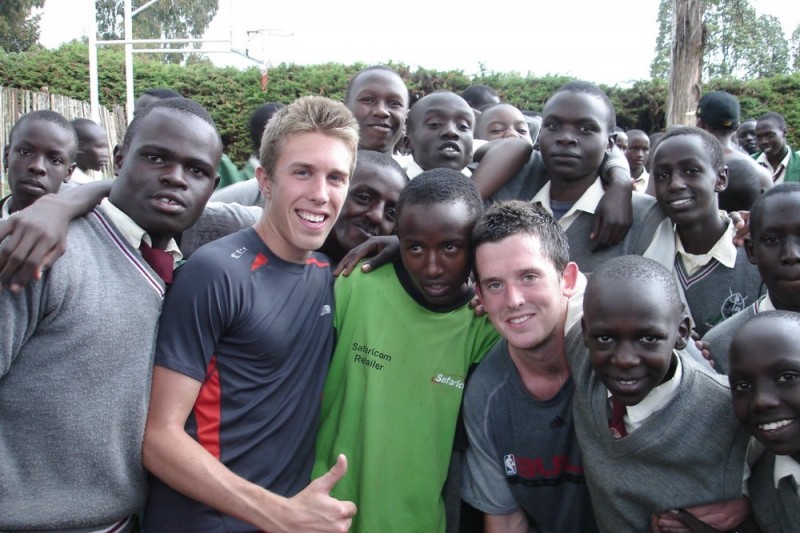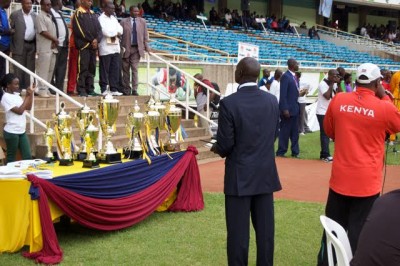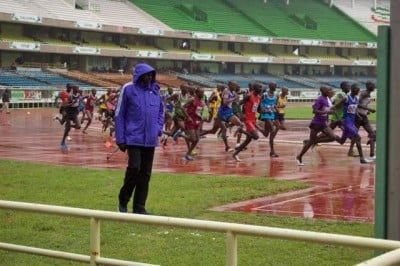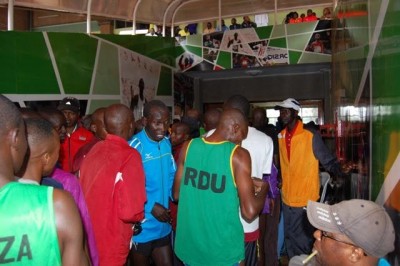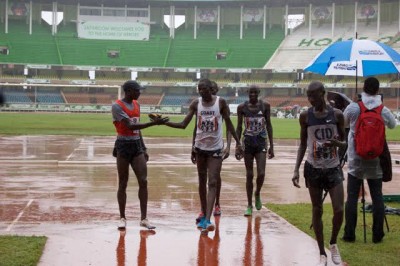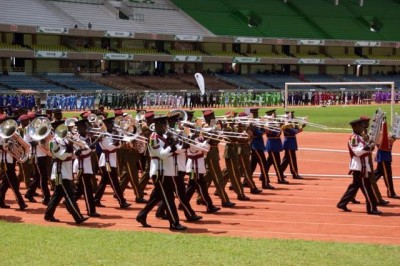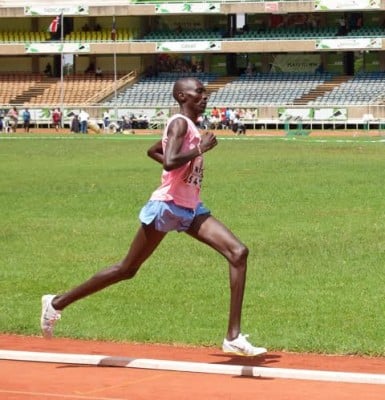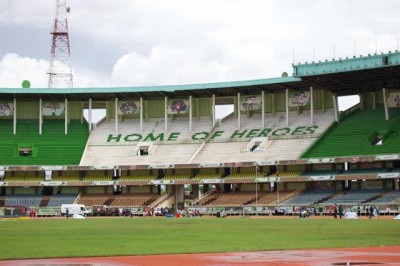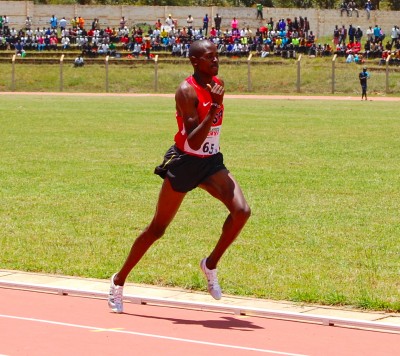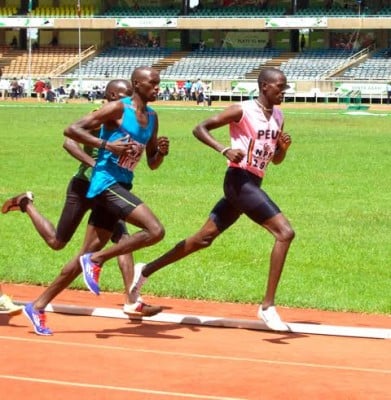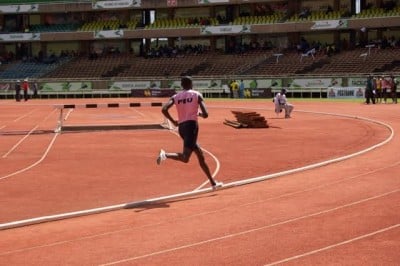Asbel Kiprop, Elijah Manang’oi And Vincent Yator Put On A Show At The 2016 Kenyan Police Championships
By Andy Arnold
April 28, 2016
Editor’s note: Andy Arnold ran for LetsRun.com co-founder Robert Johnson at Cornell for three years (he ran under Zeb Lang his final year) and did a fifth year at Ohio State under Brice Allen. A 4:19 performer in HS, Arnold improved to PRs of 3:47, 8:09, 14:09, and 29:35. Johnson, Arnold and a slew of others went to Kenya in 2011 and Arnold caught the Kenyan bug. An anthropology major, Arnold recently received a Young Explorers Grant from National Geographic and thanks to that funding and the support of many others, including LetsRun.com, Andy will be in Kenya for the next five months. This is his fourth dispatch from Kenya; you can read the previous three here.
NAIROBI, Kenya – In 1997, the United States Army instituted a program specifically designed to bolster the Olympic dreams of its servicemen and women. Aptly named the “World Class Athlete Program” (WCAP), it provided a means for elite athletes that have committed their lives to serving their country to do so in a way that transcended their normal soldiering duties. Soldiers that showed elite athletic potential could apply for the WCAP, and if selected, were invited to train and be coached in the Army’s athletic facility in Fort Carson, Colo. After nearly two decades, this program has been highly successful, sending over 15 soldiers to the Olympic Games since its founding. A few of these exceptional soldiers have also been elite runners. Letsrunners may recall a piece written by Jonathan Gault last October, “For the Love of Running,” that detailed the incredible journey of Kenyan-born serviceman Elkanah Kibet. After running an inspired debut marathon in two hours and eleven minutes, Kibet was accepted into the WCAP to chase Olympic dreams as “a warrior and member of a team …” Although Kibet is still working toward punching his Olympic ticket (he finished 19th at the Olympic Marathon Trials), he is one example of the many servicemen and women that have been able to elevate their physical pursuits thanks to the military’s commitment to support its soldiers in all endeavors, even Olympic ones.
Over the years, each branch of the American military has created a similar program modeled after the Army’s, most notably the Air Force’s WCAP. But for all of the successes had by America’s World Class Athlete Programs – and I hope that their achievements will only continue to grow – our service programs could stand to learn a thing or two from one half a world away.
In Kenya, athletes training and competing for the military or other public service forces is old news: 91 years old to be exact. In 1925, a racist colonial named R.G.B. Spicer traveled from Britain to the Rift Valley, and once there became Kenya’s Commissioner of Police. Spicer may have been an ignorant bigot, but he loved athletics, and he quickly mandated that all of Kenya’s boys in blue participate in track and field. It proved to be one of the only good decisions Spicer would make. Kenya’s police forces took to athletics well, and soon gained a reputation throughout the region of being the most “sporting.” Not willing to be outdone, the Kenyan Defense Forces (KDF) followed suit in 1935, going as far as to build a track and field stadium and actively recruit Maasai warriors to join their athletic ranks. This early rivalry between the two service forces would turn fierce in the years to come, and thankfully for track fans, would also produce some of the greatest athletes the world has ever seen. Perhaps you have heard of Kipchoge Keino. Well, before beating Jim Ryun in the Mexico City Olympics, he was an active officer in Kenya’s police force. Keino’s 1,500 victory was a moment that changed history, and is even more incredible given that he could only train around four times per week because of his policing duties.
As international athletics has become increasingly more professional, with major corporate sponsors and huge sums of prize money at stake, so too have Kenya’s service forces. Today, athletes are recruited into one of three programs: the Police, the KDF, or the more recent Prison force. This trifecta of athletic programs squares off each June at Kenya’s national championships, and victory is sorely sought after. Winning this championship provides the triumphant branch with more than just bragging rights; it can boost the overall enrollment of the force. Athletics has become a highly effective marketing tool in Kenya, where it is a lucrative endeavor not just for the Kenyan athletes but for the country’s service branches as well.
Historically, each branch has enjoyed its own time at the top of Kenya’s athletic mountain, but today, that place of honor is held securely by the Police. And their dominance is indisputable. At the World Championships in Beijing last fall, all seven of Kenya’s gold medals went to members of its police force. Julius Yego (javelin), Nicholas Bett (400 hurdles), Vivian Cheruiyot (10,000), Asbel Kiprop (1,500), Ezekiel Kemboi (3,000 steeplechase), David Rudisha (800) and Hyvin Kiyeng (3,000 steeplechase) have all proudly donned the navy blue singlets with “POLICE” branded across their chests in plain white lettering. In fact, the Police uniform is among track and field’s most difficult singlets to earn. Making this team no easy task, and as I watched the Police Championships held in Nairobi this past weekend, it certainly felt like a foreshadowing of what’s to come in Rio this August. The depth of talent within this team is borderline unfathomable, but for all of the outstanding officers that competed in Kasarani Stadium last week, three athletes delivered performances that still managed to outshine the backdrop of athletic brilliance.
The Legend Of Vincent Yator Is Growing
I arrived at Kasarani Stadium early Thursday morning, after winding my way through Nairobi’s busy thoroughfares and heart-stopping traffic. The sky was overcast and the clouds seemed swollen with rain, but that did little to dampen my spirits going into these Police Championships.
Walking out onto the stadium’s infield, I spotted John Litei leaving the coaches’ meeting. Litei, who currently has the honor of serving as Renato Canova‘s second in command, is also head coach of the Police’s “Central” team, one of the 27 districts that compose the national police force. The Central team’s colors are bright red, but Litei was wearing his classic purple adidas jacket and white Nike Dri-FIT tee with “Qatar” written in burgundy letters across the front. Litei was an incredible middle distance runner once upon a time, a Maasai that could run 45-flat in the quarter mile on a dirt track and 1:44 in the half. His bronze medal in the Commonwealth Games a decade ago was his best finish in international competition, before injury kept him from blossoming into a global sensation like David Rudisha. But today, his passion for coaching is giving young athletes a chance to do what he never could, and I was thankful that Litei was willing to give me private access to this competition, not to mention a district team to cheer for.
After greeting John, he urged me to head inside, claiming that it would rain very soon. I didn’t even bother to protest. If there is one thing that I have learned while in Kenya, it is that a Maasai doesn’t predict the weather, he KNOWS the weather. Sure enough, the moment we entered the competitor’s tunnel, the rain started coming down in buckets. But despite the equatorial washout, the race officials continued to go about business as usual, calling the first heat of the men’s 5,000-meter prelims. Among the seemingly endless small and slender bodies of Kenyans that poured into the tunnel, I spotted Vincent Yator. Yator trains in Canova’s group, and I have had the good fortune of getting to know him personally over the past month. He is an easygoing person with a great sense of humor and is always quick to smile. But that pleasant and tranquil demeanor obscures a fierce competitive fire that simmers just beneath the surface, the blaze of which I’ve only caught glimpses of at Canova’s practices.
The last time I saw Vincent, he was chasing down 1,500-meter runners at Eldoret’s Athletics Kenya track meeting. Today, he was more in his element. The 5k and 10k are Mr. Yator’s specialties (Editor’s note: he has PRs of 13:04 for 5,000, 27:34 for 10k (road) and 59:55 for 13.1), and I was hoping that he could earn a high finish over these next few days. Dressed in a purple Nike top and sporting his typical grin, he looked ready to race. Calling out from beyond the mob of distance runners, I shouted, “Win it, Vince!” He turned and smiled even bigger than usual, confidently throwing me a “thumbs up” before darting out of the tunnel into the thick, warm rain.
Behind a curtain of water, I could see about 25 men nervously waiting along the 5,000-meter start line. Most I failed to recognize, but Coach John was quick to point out a few of the headliners.
“Two men down from Vincent, in the orange top, that’s Isiah Koech. The [2009] World Youth champion …” He gave me a quick smirk, as if to say that Isiah’s age was about as accurate as me claiming to be Kenyan, but then continued, “And at the end there, that is Titus Mbishei. 13-minute 5k runner, and sub-27 minutes in the 10k. It will be a good race.”
(Editor’s note: Mbisehi has run 13:00.04/26:59.81 and Koech has run 12:48.54)
It was. The gun sounded and the race was off, with Yator, Koech and Mbishei quickly moving to the front. These three athletes contrasted sharply with each other’s running styles and builds. Koech is broad and powerful, with a strong stride that appeared to whip the track with his spiked feet as he propelled himself down the Tartan surface. Mbishei is long and lithe, with a slight lean that gives him the misleading appearance of being winded. Yator looked small in comparison to both of his rivals, but far more smooth, and his light, quick strides allowed him to float along the track as a model of efficiency.
The threesome started out running 65-second pace despite the rain, with each of the men swapping pacing duties every couple laps. By 3k, it was a three-man race, and Yator was up front. The tunnel was electric with excitement, and I was almost pushed out into the rain by the runners behind, as the entire second heat was trying to peer over my shoulders as the action unfolded.
With 600 meters left to run, Koech made a powerful surge that left Mbishei helpless to respond. Yator, however, was hot on his heels. Their order remained the same at the bell and through the back stretch, but with 150 meters left to run, Yator sprinted ahead to win convincingly in 13:41. The tunnel erupted with cheering, and I couldn’t help but join them. Coach John seemed calm however, and when I asked him why, he immediately put everything in perspective, “This is only the warm up. The real racing will begin on Saturday in the 10k final.”
Two days later, under sunny skies, the “real race” lined up behind the 10,000-meter start line. This final featured Yator, once again dressed in his purple Nike top, but the competitors had changed. Included in the field of 40+ athletes were former St. Patrick’s star Augustine Choge, coming off a bronze medal in the 3,000 at World Indoors, 26:51 man Emmanuel Bett, marathoner Joseph Kitum, and drug cheat Mathew Kisorio. All stood in Yator’s way of earning a spot on the “national team” (which in Kenya means that you are the top athlete in either the Police, KDF or Prisons) and a berth in June’s National Championships (separate from the Olympic Trials). With such a vast array of talents, from Choge’s 3:29 1,500-meter speed to Kisorio’s 58-minute half marathon strength, there was no clear path to victory. This race was sure to be a dogfight.
Like most of the races I have seen in Kenya, the 10k began in a dead sprint, with the top athletes quickly forming up at the front of the massive field. All of the contenders were there, with Kisorio in a green adidas kit at the lead. They passed through one kilometer in 2:45, well clear of the laboring “peloton,” but gradually settled into a more comfortable, 68-seconds-per-lap pace. Like a metronome, they continued to clip off 68s, the athletes trying their best to feel the others out. Each man took a turn leading, although I couldn’t tell if it was out of etiquette or a nervous excitement. After 5k, the pace began to slow. Yator, sensing that 72-second pace was too pedestrian for his tastes, took the reins with 4,000 meters remaining and gradually began to grind his challengers into dust. A 66-second 15th lap proved to be the end of Kisorio, but Vincent was relentless. He maintained 4:20 mile pace over the final 3,000 meters, which proved too much for Bett and Choge to handle. With only 600 meters to go, it was a two-man race. Yator was shadowed by the tall figure of Kitum until the bell, at which point the easygoing Yator unleashed his competitive fire. Yator launched into a furious final kick, gapping Kitum almost instantly. Once again, the Police forces went wild as Yator flew down the homestretch to cross the line in 28:15. I clocked his last lap at 60 seconds even.
It was an impressive finish, and a well-earned victory. But I was shocked to discover that Yator wasn’t yet finished. 90 minutes later, the starter lined up 25 men to compete in the final of the 5,000 meters. Standing just inside of Isiah Koech was the small, purple-clad figure of Vincent Yator. Amazingly, he was going for the toughest double of the meet.
The gun sounded and the runners took off again at a suicidal pace. The sprint only lasted for around 200 meters, and when the dust settled, Koech was at the helm. The race then began to unfold without much drama, fluctuating between 67- and 64-second pace. Unlike the 10k, Yator dropped back into the pack for much of this race, clearly content to let someone else do the work. At around 3k, I half expected him to drop out, but with a gap opening up between the chase group and the leaders, he surged ahead and tucked in behind Koech. With only a kilometer remaining, six athletes were still in contention, but no one seemed willing to make the first move. With chopped strides and the men running four-wide, they labored their way through the next 400 meters in around 69 seconds.
But that was calm before the storm. At a lap-and-a-half remaining, the entire front pack started to accelerate, leaving Yator in the fourth position at the bell. But Yator refused to be dropped, and as the leaders tore down the backstretch amid the roar of their fellow policemen, Yator slowly clawed his way back into striking distance. On the final turn, he was right on the leaders’ shoulders, and I could see that he was ready to make his bid for the win. But just as he started to shift gears, he was nearly knocked over by an elbow delivered by Koech, who surged into the lead, leaving Yator to gather himself with only 150 meters remaining. Yator was undeterred, however, and with each stride he seemed to gain on Koech down the backstretch. Both men were in a frenzy, with arms beating the air and teeth clenched as they pulled even over the last 80 meters. But Yator would not be denied victory. He sprinted by Koech in the final 15 meters to a time of 13:43. His last 200 meters were covered in 26 seconds … on tired legs.
It was an incredible double given the level of competition at the meet and the short time between races. When I caught up to Vincent after the race, he was all smiles once again. After asking him about the crazy double, he explained that he had not planned to do both races that day, but a last-minute change in the meet schedule forced him to change his mind.
“But I did not struggle today, and if continue like this, I should qualify for the Olympics in the 10,000 meters,” Yator said.
It is a bold prediction, especially since the likes of Geoffrey Kamworor, Paul Tanui and Bedan Karoki (all of whom beat Yator convincingly in last year’s World Championship Trials) will be ready to challenge next time. But one win at the Kenyan Police Championships is not to be taken lightly, let alone two. So it may be wise to remember the name Vincent Yator over the next few months.
Asbel Kiprop Is A Giant Among Men
I have mentioned Kiprop in every single one of my dispatches from Kenya. If that seems redundant, I apologize, but to ignore his unparalleled ability on the track would be like ignoring Christie Brinkley driving by in a red convertible. It’s impossible. And after witnessing the Police Championships this past weekend, it may be just as impossible to beat this man in a 1,500-meter foot race.
I first spotted Kiprop during the second day of the competitions. His tall, slender figure would seem to be commonplace among the Kenyan athletes, but his six-foot-three frame makes him appear a giant on the track. Dressed in a teal Nike track suit with gold striping, a person who can’t even spell Asbel would know that this athlete is special. But the 2008 Olympic champion is doing things this April that Kenyans have not ever seen before; his form is simply otherworldly. This became clear during the semi-finals of the men’s 1,500 meters.
There were three heats of the 1,500 semis at the Police Championships. The first was won by Collins Cheboi, a product of the Canova-Litei training group who ran 3:30.34 in Monaco last year. He has been recovering from a slight pull in one of his calves. Despite the injury speed bump, Cheboi cruised to victory over a field of roughly 20 men. His easy victory was mirrored in the second heat by Nixon Chepseba (3:29.77 PR, 4th at 2013 Worlds), another Canova-Litei athlete. But just as it was beginning to look as if these men would pose a serious challenge in the final, the great Asbel Kiprop entered the stadium.
Kiprop was dressed in a curious pink-colored top, with P.E.U. written on the chest. He was the first athlete I had seen sporting this color scheme, and I asked Litei what it meant.
“The pink is the color of the Presidential Escort Unit. You must be the absolute top to be invited into that group by President Kenyatta,” he said.
There is no question that the three-time world champion Kiprop is the “absolute top” when it comes to running 1,500 meters, and his tactics in the third heat made it clear to me and everyone else in the stadium that he knows it too.
It was a quick start, with the sound of the starter’s gun sending the 20+ officers/athletes off into a mad dash for the first turn. That is, everyone expect Kiprop. While the athletes up front jostled for position, the Olympic champion was comfortable to hang back, allotting the entire field five meters before even reaching 200 meters. The leaders must have sensed that Kiprop was nowhere to be found, because they foolishly slowed their pace. It was amusing watching this pack of elite athletes run scared for the next two laps; they ran like a herd of antelopes anxiously waiting for a faster predator to strike. But Kiprop remained patient, even at the bell, when the leaders had a good 15 meters on him.
On the backstretch, the 3:26 1,500-meter man started to pick up steam, effortlessly closing the gap and reaching 200 meters to go in the fourth position. There was still a lot of ground to make up in a short amount of time, with the leaders now in a terrified sprint knowing the inevitable was about to happen. At 150 meters to go, Kiprop shifted into a gear no one else on Earth possesses, teleporting himself next to the struggling leader, Abraham Kiplagat (1:43/3:39). They ran stride-for-stride down the homestretch, and for a moment I thought Kiprop was going to allow Kiplagat to win. Kiprop seemed to relax about 40 meters before the line, giving his opponent a slight lead that caused Kiplagat to drop his guard. It was poor choice, because Kiprop once again catapulted himself past the sorry soul to win in 3:44. The stadium was howling with laughter, and even the race officials couldn’t help but smile. The Olympic champ was putting on a show, toying with the race with such ease that it was almost unfair. But this is only the semifinal, I told myself. Tomorrow would be a different story.
****
Tomorrow came, but the story was the same. It was just before noon when the starters called the men’s 1,500 finalists to the line. About 20 of Kenya’s best middle-distance runners came jogging out of the tunnel, each proudly wearing their team singlet, a multitude of colors representing the various divisions of the police force. The crowd was larger today, and the hoots and hollers of their fellow officers drew a few smiles from the competitors. Nixon Chepseba and Collins Cheboi, however, wore faces that may as well have been etched in stone. Today was not an exhibition or a game; it was an opportunity to slay a giant. And with credentials such as a 3:29 1,500-meter PR (Chepseba) and a 3:49 mile PR (Cheboi), it wasn’t – at least on paper – fantasy to believe one of these two men could deliver a storybook ending that Saturday.
And then came the giant … dressed in pink. Kiprop pranced out of the tunnel wearing his Presidential Escort Uniform, looking like a man about to enjoy a brisk jog to start his day. The rest of the race was waiting for him, and the starters beckoned him over to the first position on the line. The stadium hushed itself as the starter yelled “on your mark” and time seemed to stop during those agonizing seconds between the set and the gun. BANG! The final was off, with Chepseba and Cheboi quickly surging to the lead. Kiprop once again slipped into last place, but didn’t grant the other competitors as much space as he did in the previous day’s semi.
I had posted up on the outside of the 200-meter turn, and as the field flew by, a large gathering of race officials left their posts to watch the race unfold beside me. They knew this race was going to be special, and I assume they were eager to get splits. The first 300 meters was eclipsed in 43 seconds, a decent start, but the pace began to dawdle around the turn. Then, to everyone’s surprise, Kiprop sprinted to the lead and ratcheted down the pace for the next 200 meters. Cheboi and Chepseba were close behind, or as close as you can be to Kiprop’s long and loping stride. Kiprop looked unbelievably smooth running down the backstretch and didn’t show even the slightest sign of effort, a sharp contrast compared to his competitors, who were straining to keep up with the injection of pace. But just as I was beginning to get excited for a truly fast race, Kiprop pulled into lane two and dropped back into last, a tactic that confused the field as much as at did me.
Cheboi and Chepseba were done playing games however, and decided to make the world champ pay for his willingness to toy with them. They crushed the third lap, running 56-mid, and succeeded in stretching out the field to its breaking point. But their plan did nothing to dissuade Kiprop, and at the bell he was running in the two leaders’ shadows. The race was in full flight now, and the crowd was loving it. Coming down the backstretch, Cheboi was giving it everything he had, and the furious pace proved too hot for Chepseba, who started to fade. But a resurgent Abednego Chesebe (a 1:45/3:35 performer) was hanging a tough, and at 200 to go, both men had about an eight-meter gap on Kiprop and showed no signs of slowing down.
Unfortunately for Cheboi and Chesebe, the pink-clad giant was speeding up. With each impossibly long stride, Kiprop gained ground, and as they came out of the final turn, it looked like Cheboi and Chesebe’s situation was hopeless. But just as Kiprop was about to pull even with them, he stopped accelerating. Everyone in the stadium, including me, held their breath. Was he hurt? Did he run out of gas? Had his rivals found another gear?
It was a split-second moment in which the Olympic champion appeared vulnerable, human even. But it was only a feint. Kiprop calmly turned to the grand stands, and in stride managed to smile and wave, only to then, once again, shoot by his rivals like a bullet from a gun. He crossed the line in 3:40, looking like he had just finished a warmup. Chesebe and Cheboi meanwhile, collapsed behind him in second and third place, bewildered by what just happened.
It bewildered me as well. Watching this race was an entertaining, and yet frightening spectacle (many of Kiprop’s races are; remember last summer’s Emsley Carr Mile?). The 1,500 on Saturday featured a field of high-quality athletes; Collins Cheboi and Nixon Chepseba are world class in their own right. But in the final, even they were made to look like JV athletes racing the state champion at a high school dual meet. If Kiprop can continue improving over the next four months, it’s hard to imagine any other man, machine, or demigod beating him in Rio.
The Future Of Middle-Distance Has A Name, And It’s Elijah Manang’oi
Kiprop may be unbeatable, but then again, one should never count out a Maasai. After the Thursday prelims, I had the privilege of driving back to the city with 2015 1,500 World Championships silver medalist Elijah Manang’oi. The 25-year-old Maasai has been sensational this year, cruising to victory in every race he’s entered (I know that the IAAF has his birthday listed as 1993, but 25 is what he told me. In fact, he claimed that we were age-mates, a term used by Kalenjins and Maasai that designates persons born around the same year. Since I’m 25, you can rest assured that Elijah is too. He also said that his name is spelled “Manang’oi,” not “Manangoi” as listed on the IAAF site). Two weeks ago in Eldoret, he negative-split his way to a convincing win in the 800-meter semis, rocking a USA singlet en route to running 1:46 at 7,000 feet of altitude. This weekend, he was again looking to fine-tune his speed with a couple of 800-meter efforts. I knew that Manang’oi had originally been a 400-meter runner, and as we careened down Nairobi’s highways in his black Subaru Forester with Nike swooshes on the front and back, I asked him how he managed to transition from a long sprinter to miler.
“It only took about two weeks,” Manang’oi replied with a smirk. My doubtful look prompted him to continue.
“Seriously! I was always training hard for the 400, and much of that training worked for 1,500. My weeks were full of running 40- to 50-minute runs between my speedwork days. So when my manager encouraged me to move up in distance, it just came easy.”
Manang’oi’s manager is Jukka Harkonen, a Finnish agent who is a dear friend of the young Maasai. His respect for the elderly manager was so great, in fact, that above both Nike swooshes read, “Jukka” in an italic font: he named his car after his agent.
“I would not be the runner I am today without my manager,” Manang’oi said. “When people are good to you, you must be good to them in return.”
It was impossible for me to not be astounded by the young man’s almost supernatural talent. I have heard of long sprinters making successful moves to the middle distances before, but to go from a 400-meter runner to the world silver medalist at 1,500m in only a few years … well, that’s almost providential. I guess that’s why I wasn’t surprised to discover the meanings behind his names. “Elijah” is his given Christian name, the name of one of the greatest prophets in the Bible, who is supposed to have been able to outrun chariots (1 Kings 18:46). And as for the Maasai word Manang’oi, “It means many things,” said Elijah, “but most of all, it means blessed.”
All I can say is that after watching Manang’oi race the two-lap distance twice over the past weekend, its obvious that he has a gift. In the Friday semifinal, Elijah absolutely torched his competition, sprinting away over the last 150 meters from a field of Kenya’s finest 800-meter athletes to a time of 1:47. During his race, I was standing at the 200-meter mark, and when I shouted some encouragement to Elijah, he just winked and gave me a “thumbs up” before catapulting himself around the turn to win by over a second. After the race, he told me, “I was relaxing today, just wait for tomorrow.”
True to his word, the final of the men’s 800 meters was something to behold. It featured a talented cast of characters, including Jeremiah Mutai (1:43.9h 800-meter PR), Timothy Sein (2:17 1k PR) and Job Kinyor (1:43 800-meter PR). But as the competitors emerged from the tunnel that Saturday afternoon, all eyes were fixated on the young Maasai in the pink singlet. Like Kiprop, Manang’oi was a member of the Presidential Escort Unit, and most likely the youngest athlete to have been invited by President Uhuru Kenyatta. As he took his strides before the race, it was hard to imagine a better form for running the middle-distances. Manang’oi has a slender yet muscular body with long limbs that extended his stride to lengths envied by taller athletes. His posture is aggressive as well, with his torso and hips constantly pressing forward in such a way to give one the impression that his whole being was begging to go faster. After being called to his start line in lane 6, he was afforded that opportunity.
The gun fired and the eight racers charged around the turn, staying in their lanes until the break on the backstretch. This final featured a rabbit, and he was making certain that the race was anything but slow. Hitting the 200-meter mark in 23-mid, the competitors were already strung out single-file, with Manang’oi looking good in the fifth spot. They reached the bell in 49-high, and the rabbit slid out into lane two, his work finished for the day. That’s when Kinyor charged to the lead, shadowed closely by Sein and Mutai. Manang’oi was still lurking back in fifth place up until the pack hit 250 meters to go. There, Manang’oi launched into his signature kick, shooting into the lead with only 200 meters remaining. The entire police force was in a frenzy, cheering Elijah on to what we all hoped would be a fast time.
But right at the start of the final turn, Manang’oi did something strange. He looked backed at his teammate from the PEU, and pointed at him to come up and run on his shoulder. The fellow PEU athlete obliged, and the two men in pink singlets cruised down the final turn together, effectively blocking out their competitors from passing. It was an odd show of sportsmanship, but a powerful demonstration of how confident Manang’oi is in his kick. Coming off the final bend, with the top two spots safely in the PEU team’s hands, Manang’oi shifted gears and rocketed across the final 90 meters, waving to the crowd and sticking out his tongue in stride as he crossed the line in a world-leading 1:44.1. Manang’oi must have been watching some of Usain Bolt‘s highlights from the 2008 Olympic final.
The show of sportsmanship and showmanship was exciting and entertaining, but the potential that Manang’oi has as a middle-distance runner is mind boggling. Speaking to Litei after the race, we both agreed that Manang’oi could have run 1:42 Saturday had he not toyed around over the final 300 meters. That’s scary speed considering that the man is a 1,500-meter runner. But it’s not just that Manang’oi is fast, but that his speed late in a race is incredible, maybe even unparalleled (watch his close in last year’s World Championships final for proof). And at only 25 years old, the sky may be the limit for this young Maasai. But can he reach that pantheon-like level of form by August?
“As long as I keep concentrating on the Olympics, who knows?”
Discuss this article on our world-famous message board / fan forum: MB: Andy Arnold’s latest piece from Kenya is now up – Learn how Asbel Kiprop totally toyed with 3:29 guy and 3:49 guys.
